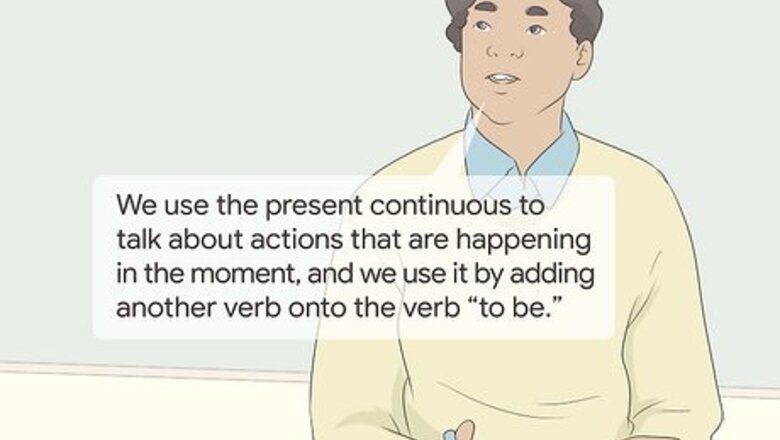
views
Introducing the Present Continuous Methodically
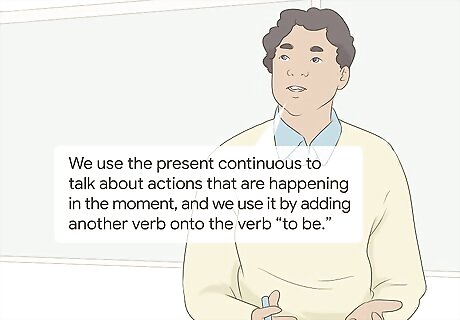
Explain that this tense is used to talk about what’s happening now. Start by telling your student or class what the present continuous is and why it’s used. For example, you might say, “We use the present continuous to talk about actions that are happening in the moment, and we use it by adding another verb onto the verb “to be.” Give 1 or 2 examples right after explaining the definition so the students have an idea of what it is. An example might be, “I am teaching,” or “You are listening.” Review the definition of a verb and go over a couple examples with your students.
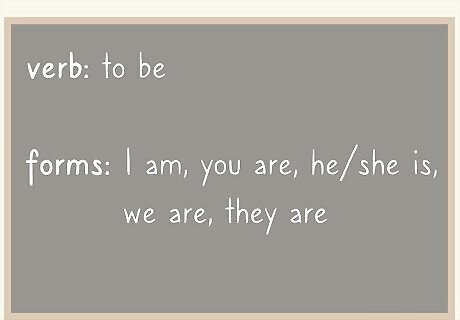
Review the verb “to be” and all of its forms. It’s important that your student or class understands each form of the verb "to be" so that they can recognize and use them in the present continuous. Review each form of the verb “to be”: "I am," "you are," "he/she is," "we are," and "they are." Write each form on the board or a piece of paper after you talk about them to help visual learners.
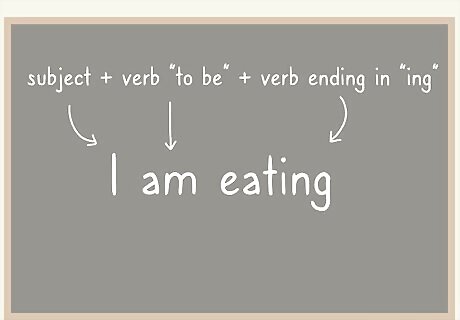
Write the equation for the present continuous on a board or paper. Show students that this tense is created using the verb “to be” and an action verb ending in “ing.” Do this by writing an equation for the tense on a visible board or piece of paper, followed by 1 or 2 examples so they can see how it works. Encourage students to write the equation and examples down so they practice creating the tense. For the equation, you might write: Subject + verb "to be" + verb ending in "ing."
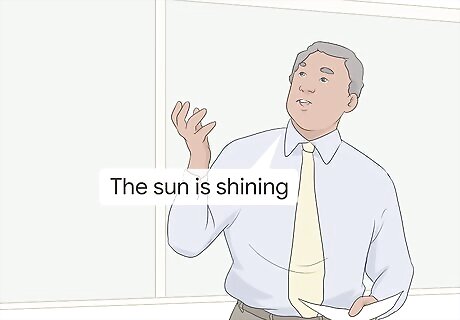
Give examples to demonstrate how to use the present continuous. Once your students have a general understanding of what the present continuous tense is, start giving them lots of examples so they begin thinking of examples on their own. Some examples might be, “You are writing,” or “I’m walking around the classroom.” Point out the subject, “to be” verb, and the verb ending in “ing” in each example. After you’ve given several simple examples, move on to giving examples of other things that are happening right now: “The sun is shining,” “Your mother is working,” or “The leaves are blowing in the wind.”
Teach the negative form by adding "not" to the present continuous. The negative form of the present continuous is created by adding "not" after the verb "to be," such as "I'm not eating." Give your students simple examples of the present continuous and practice turning them into negative statements using the negative form. For example, you might give your students a list of sentences in the present continuous and ask them to change them into negatives.
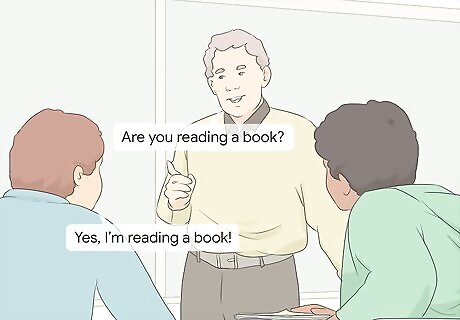
Ask questions to teach students the interrogative form. Turn the present continuous into a question to teach the interrogative form: “Are you listening to the teacher?” or “What are you doing?” Have the student or class answer your questions in a yes or no format, stating the complete sentence in the present continuous tense, or give them a statement and ask them to turn it into an example of the interrogative form. For example, if you asked, “Are you reading a book?” the students would either answer, “Yes, I’m reading a book!” or “No, I am not reading a book.” This shows how to make the present continuous negative as well as interrogative.
Reinforcing Through Games and Activities
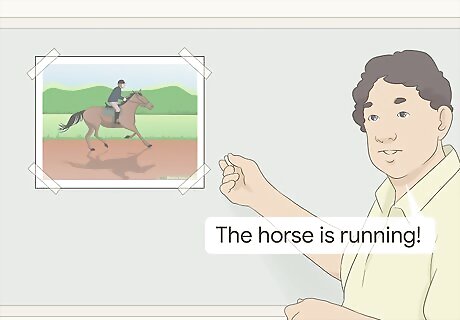
Play Pictionary to have students guess the action that’s being drawn. Write different verbs or sentences on slips of paper and place them in a bowl. Have a student pick a slip and try to draw the action that’s written on the piece of paper while the rest of the students try to guess what’s being drawn. The student that guesses the action correctly and says it in the present continuous gets to draw next. For example, a student drawing a horse in a field with its legs moving might be encouraging other students to guess, “The horse is running!” or something similar. When writing the slips of paper with verbs or short sentences on them, choose subjects and actions that aren’t too difficult to draw.
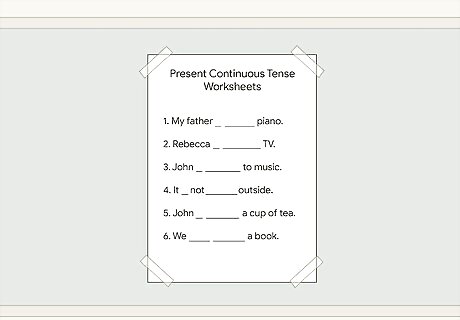
Create worksheets that reinforce the present continuous tense. Either make your own worksheets to practice the present continuous, or download pre-made worksheets online—there are lots to choose from! The worksheet could have fill-in-the-blanks, matching items, or a section that asks you to circle examples of the present continuous tense. The worksheet might give students a verb and ask them to turn it into a sentence in the present continuous. To find worksheets on the present continuous that are already designed, type “present continuous tense worksheets” into an online search engine. Worksheets are a great way to practice the negative and interrogative forms of the present continuous.
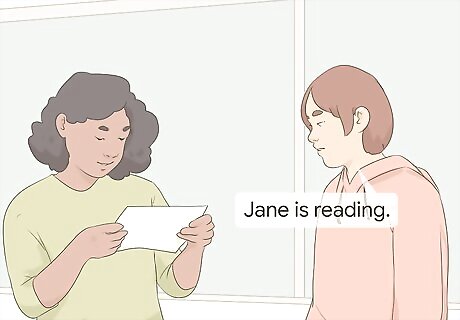
Act out actions while others guess the action in the present continuous. Create slips of paper that say different simple actions such as “sitting” or “singing.” Have a student pick out a slip of paper and act out the verb while the others try to guess using the present continuous tense. For example, a student might get a slip that says, “Reading” or “I am reading.” The student would act this out while the others try to guess, “You are reading!”
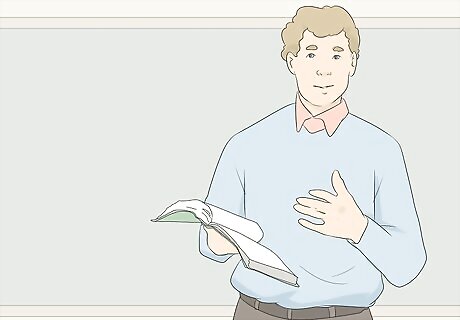
Find examples of the present continuous in books or magazines. Separate students into pairs and give each of them a magazine. Ask them to look for pictures of something happening and write down what the action is in the present continuous tense. To make it harder, you might ask them to look for examples of the present continuous in books or newspapers. If you have lots of magazines or just a few students, give one to each student instead of separating them into pairs, if desired. Encourage them to write down each full sentence that goes with a picture to help them practice forming the tense.
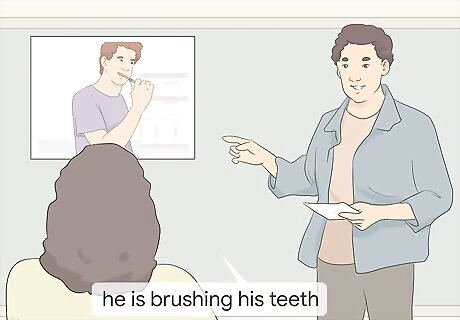
Show action flashcards to have students practice forming the tense. Purchase action flashcards from a teacher store or online, or create your own by printing out pictures or cutting out action pictures from magazines. Show a flashcard to your student or class and have them tell you what action is happening in the correct form of the tense. For example, if you show a picture of a girl holding a toothbrush to her teeth, students would say, “She is brushing her teeth.” If you have more than one student, have them raise their hands to show that they know how to say what’s happening in the present continuous.
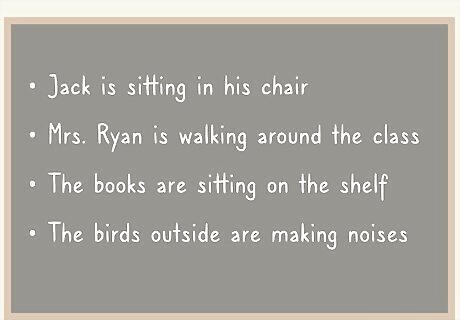
Write things that are happening in the room in the present continuous. Give each student a piece of paper and a pencil. Ask them to look around the room or out the window and write down as many different sentences of things happening in the present continuous as possible. Make this a simple exercise just for practice, or turn it into a competition to encourage students to write as many sentences in the present continuous as possible. Give the students a couple examples before they start to help them begin brainstorming. Students might write, “Jack is sitting in his chair,” “Mrs. Ryan is walking around the class,” “The books are sitting on the shelf,” or “The birds outside are making noises.”
Have students make up questions to practice the negative and interrogative forms. Encourage students to use names of other kids in the class or items around the school and create questions, such as, "Is Lizzie riding a bike?" or "Are the chairs blue?" Then have the class answer the questions in a yes or no statement so they're practicing both the negative and interrogative forms of the present continuous. For example, have each student write 1-2 questions in the interrogative form on a slip of paper. Pull out each slip of paper and ask the class the question, having them respond in a yes or no statement.














Comments
0 comment